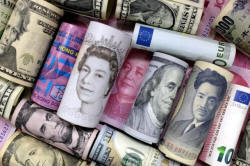Dollar limps up from three-year low after worst week in
nine months
 Send a link to a friend
Send a link to a friend
 [February 16, 2018]
By Jemima Kelly [February 16, 2018]
By Jemima Kelly
LONDON (Reuters) - The dollar limped up
from a three-year low against a basket of currencies on Friday and was
headed for its biggest weekly loss in nine months, as negative sentiment
offset any support the greenback could take from higher Treasury yields.
The U.S. currency has been weighed down by a variety of factors this
year, including concerns that Washington might pursue a weak dollar
strategy and the perceived erosion of its yield advantage as other
countries start to scale back easy monetary policy.
Traders' confidence in the dollar has also been eroded by mounting
worries over the United States' twin current account and budget
deficits, with the latter projected to balloon to near $1 trillion in
2019 amid a government spending splurge and hefty corporate tax cuts.
Falls in the dollar have come as U.S. Treasury yields have hit four-year
highs and as stronger-than-expected U.S. inflation has bolstered bets
that the Federal Reserve could increase interest rates as many as four
times this year.

That has left many analysts puzzled, as higher Treasury yields are
normally associated with a stronger dollar.
As 10-year Treasury yields <US10YT=RR> edged back below the 2.9 percent
mark on Friday, the dollar strengthened, with its index gaining 0.3
percent and the euro falling back below $1.25 from a three-year high <EUR=>.
MUFG's European head of markets research in London, Derek Halpenny, said
Treasury yields had been driven higher not by expectations for stronger
growth, but by fears about fiscal instability and inflation spiralling
out of control. This was the reason an inverse correlation was emerging
between the dollar and long-term Treasury yields, he said.
"The worry (over)....Trump's policy direction...has longer-term risk
implications that I think could become a 'triple-sell' on assets - with
equities, bonds and currency sold off - where you enter this phase of a
loss of confidence in dollar-related assets and policymaking," said
Halpenny.
[to top of second column] |

Euro, Hong Kong dollar, U.S. dollar, Japanese yen, pound and Chinese
100 yuan banknotes are seen in this picture illustration, January
21, 2016. REUTERS/Jason Lee/Illustration/File Photo

"If we see some element of stability coming back into U.S. Treasury markets and
if yields start to drop back a bit, those fears are receding to some degree, and
that can then be linked to some modest recovery in the dollar."
The dollar index was on track to lose 1.8 percent on the week in its largest
decline since May 2017.
Chris Turner, head of currency strategy at ING in London, made a similar
argument to Halpenny, saying investors were requiring a risk premium for holding
long-term debt, and adding that worries the administration would pursue a
weak-dollar strategy had also knocked the greenback this year.
"The U.S. Treasury is happy to talk fast and loose about the dollar, which I'm
sure hasn't gone unnoticed by investors and other central bankers," Turner said.
The dollar traded up 0.2 percent on the day at 106.28 yen <JPY=>, having earlier
sunk to a new 15-month low of 105.545 yen.
The reappointment of Haruhiko Kuroda as Bank of Japan governor and the
nomination of BOJ executive director Masayoshi Amamiya and Waseda University
professor Masazumi Wakatabe as deputy governors were seen certain to keep the
central bank on an ultra-loose policy path.
(Reporting by Jemima Kelly; Additional reporting by Shinichi Saoshiro in Tokyo;
Editing by Toby Chopra)
[© 2018 Thomson Reuters. All rights
reserved.] Copyright 2018 Reuters. All rights reserved. This material may not be published,
broadcast, rewritten or redistributed.
Thompson Reuters is solely responsible for this content.
 |